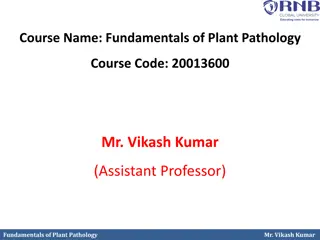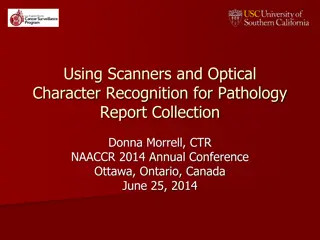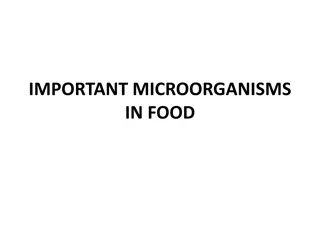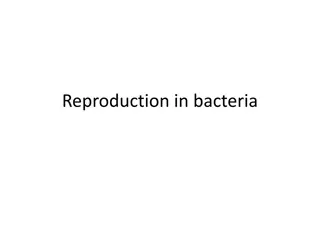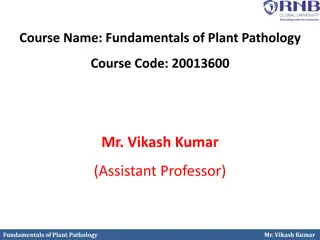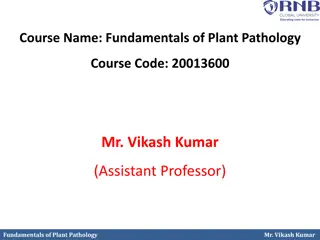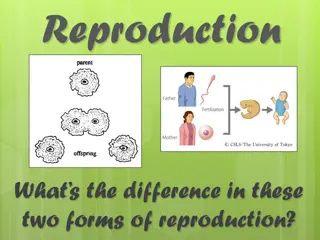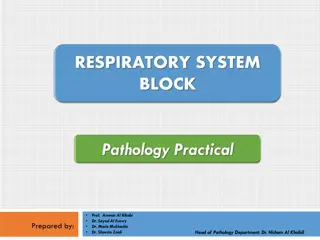Understanding Plant Pathology: Reproduction and Classification of Bacteria
This course on Fundamentals of Plant Pathology, led by Mr. Vikash Kumar, covers essential topics such as disease identification, pathogen nature, disease management strategies, pathogen classification, and plant disease diagnosis. It delves into the reproduction and classification of plant pathogenic bacteria, detailing asexual and sexual methods like binary fission, budding, conjugation, transduction, and transformation. Participants will gain insights into the genetic recombination processes of these bacteria, enhancing their knowledge and skills in plant disease management.
- Plant Pathology
- Bacteria Reproduction
- Disease Management
- Pathogen Identification
- Genetic Recombination
Download Presentation

Please find below an Image/Link to download the presentation.
The content on the website is provided AS IS for your information and personal use only. It may not be sold, licensed, or shared on other websites without obtaining consent from the author. Download presentation by click this link. If you encounter any issues during the download, it is possible that the publisher has removed the file from their server.
E N D
Presentation Transcript
Course Name: Fundamentals of Plant Pathology Course Code: 20013600 Mr. Vikash Kumar (Assistant Professor) Fundamentals of Plant Pathology Mr. Vikash Kumar
Course Objectives 1: Name and identify different Diseases, nature of pathogens and different strategies for management of plant diseases. 2: Outline concepts, nomenclature, classification and characters of pathogens 3: Apply different principles and methods for plant disease management. 4: Take a part in identification of diseases and marketing of relevant pesticides. 5: Conclude methods to diagnose and manage a wide range of plant diseases. Fundamentals of Plant Pathology Mr. Vikash Kumar
Reproduction and classification of plant pathogenic bacteria Fundamentals of Plant Pathology Mr. Vikash Kumar
Reproduction: (1.) Asexual and (2.) Sexual (1.) Asexual or vegetative reproduction of bacteria: Two process: i. Binary Fission: It is a process by which a single bacterial cell simply divides into two in half an hour time. ii. Budding: It is a process by which the vegetative cell forms a lateral outgrowth and gets separated from the parent cell or may form a colony. Fundamentals of Plant Pathology Mr. Vikash Kumar
(2.) Sexual reproduction or Genetic recombination: (1.) Conjugation: It was discovered by Joshua Lederberg and Edward Tatum (USA) in 1946 in bacterium Escherichia coli. It is the transfer of genetic material from a donor cell to a recipient cell through sex pilli or conjugation tube. The donor and recipient cells are sometimes referred as male and female cells, respectively. Fundamentals of Plant Pathology Mr. Vikash Kumar
(2.) Transduction: It was first discovered by N. Zinder and J. Lederberg in 1952, in Salmonella typhimurium, a mouse typhoid bacterium. Transduction is the transfer of DNA from a donor cell to a recipient cell by bacteriophages. In most cases only a small segment of the host (i.e. the donor) DNA is transferred. Fundamentals of Plant Pathology Mr. Vikash Kumar
(3.) Transformation: It was first discovered by Frederick Griffith (1928) in Pneumococcus pneumoniae. Transformation is the gene transfer by soluble or naked DNA, which has been extracted or otherwise liberated from a donor bacterium to a recipient bacterium through diffusion. Griffith (1928), an English bacteriologist, accidently found that the heat-killed bacteria of virulent strain (type) of Pneumococcus pneumoniae could transfer characteristics of its strain to the non-virulent strain of living bacteria. Avery, Macleod and McCarty (1944) observed that it is due to the transfer of DNA segments from the dead cells to the living cells is called as "transformation". Fundamentals of Plant Pathology Mr. Vikash Kumar
Classification of plant pathogenic bacteria. Present classification 2nd edition of bergey s manual of systematic bacteriology published in 2004, the prokaryotic organisms are divided into two domains, Archea and Bacteria, using 16 S r RNA gene sequencing. Domain bacteria is sub-divided into 24 Phyla but plant pathogenic genera are placed in only 3 phyla. 1. Proteobacteria 2. Firmicutes 3. Actinobacteria Fundamentals of Plant Pathology Mr. Vikash Kumar
A. Phylum Proteobacteria (Gracilicutes) Biggest phylum containing the gram negative (-) bacteria, classified by their rRNA sequences. 1. Class Alphaproteobacteria i. Order Rodospirales Family Acetobacteriaceae E.g. Acetobacter, Gluconobacter ii. Order Rhizobiales Family Rhizobiaceae E.g. Agrobacterium - the cause of crown gall disease Rhizobium - the cause of root nodules in legumes Fundamentals of Plant Pathology Mr. Vikash Kumar
2. Class Betaproteobacteria i. Order Burkholderiales Family Burkholderiaceae E.g. Burkholderia, Ralstonia Family Comanonadaceae E.g. Acidovorax - causing leaf spots in corn, orchids, and watermelon 3. Class Gammaproteobacteria i. Order Xanthomonadales Family Xanthomonadaceae E.g. Xanthomonas - causing numerous leaf spots, fruit spots, and vascular wilts, and citrus canker Xylella - xylem inhabiting, causing leaf scorch and dieback diseases on trees and vines ii. Order Pseudomonadales Family Pseudomonadaceae E.g. Pseudomonas - causing numerous leaf spots, blights, vascular wilts, soft rots, cankers, and galls Ralstonia - causing wilts of solanaceous crops Fundamentals of Plant Pathology Mr. Vikash Kumar
iii. Order Enterobacteriales Family Enterobacteriaceae E.g. Erwinia - causing fire blight of pear and apple, Stewart s wilt in corn Pentoea - causing wilt of corn Serratia marcescens - being a phloem-inhabiting bacterium causing yellow vine disease of cucurbits Pectobacterium, Enterobacter, Bernnaria Fundamentals of Plant Pathology Mr. Vikash Kumar
B. Phylum Firmicutes Gram positive organisms, Low G+C content Three classes 1. Class Clostridia (Anaerobic) i. Order Clostridiales Family Clostridiaceae E.g. Clostridium - causing rot of stored tubers and leaves and wetwood of elm and poplar 2. Class Bacilli ( Obligate or facultative aerobes) i. Order Bacillales Family Bacillaceae E.g. Bacillus - causing rot of tubers, seeds, and seedlings, and white stripe of wheat Clostridia and Bacilli show gram positive cell wall structure. Mollicutes do not stains in gram staining, but some have pseudo-membrane that stains gram negative. Fundamentals of Plant Pathology Mr. Vikash Kumar
3. Class Mollicutes (Lack cell wall) (Tenericutes) i. Order Entomoplasmatales Family Spiroplasmataceae E.g. Spiroplasma (Gram negative, helical but motile) - causing corn stunt (S. citri), transmitted by beet leaf hopper (Cerculifer tenellus), citrus stubborn (S. kunkelli), transmitted by corn leaf hopper (Dalbulus maidis). ii. Order - Acholeplasmatales Family Acholeplasmataceae E.g. Candidatus Phytoplasma - causing numerous yellows, proliferation, and decline diseases in trees Candidatus liberobacter phloem inhabiting, causing citrus greening disease. Fundamentals of Plant Pathology Mr. Vikash Kumar
C. Phylum Actinobacteria Gram positive bacteria with high G+C content 1. Class Actinobacteria Sub-class Actinobacteridae i. Order Actinomycetales Family Actinomycetaceae E.g. Actinomyces Family Corynebacteriaceae E.g. Corynebacterium Family Nocardiaceae E.g. Nocardia Family Microbacteriaceae Fundamentals of Plant Pathology Mr. Vikash Kumar
E.g. Clavibacter (Leifsonia) - causing ratoon stunting of sugarcane Curtobacterium, Rathayibacter Family Micrococcaceae E.g. Arthrobacter - causing bacterial blight of holly Family Streptomycetaceae E.g. Streptomyces - causing the common potato scab Division of gram negative bacteria is Gracilicutes, have cell membrane and cell wall, Division of Gram-positive bacteria is Firmicutes. Division of Mollicutes is Tenericutes, have only cell membrane and lack cell wall. E.g. Spiroplasma, Phytoplasma. Fundamentals of Plant Pathology Mr. Vikash Kumar
Thank You Fundamentals of Plant Pathology Mr. Vikash Kumar




